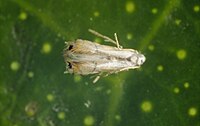
Photo from wikipedia
Simple Summary The legume pod borer is one of the most serious legume pests widely distributed in Asia, Africa, Australia, America, and Oceania. The use of synthetic pheromone lures has… Click to show full abstract
Simple Summary The legume pod borer is one of the most serious legume pests widely distributed in Asia, Africa, Australia, America, and Oceania. The use of synthetic pheromone lures has been developed as a more environmentally friendly alternative for its control. In this study, we evaluated the potential of the pheromone components as a mating disruption tool under laboratory and small-scale field conditions by identifying effective blends made out of single pheromone components or a different mix of them. The results from the laboratory experiment show that insects challenged with the blend ratio of 1:1:1 had lower fecundity and egg eclosion. A small-scale caged field experiment also showed a significantly disruption of normal mating with the above-mentioned ratio, leading to lower flower and pod damage, and higher mungbean yield. This study provides new evidence about the possibility to use pheromone components for mating disruption; however, more research is needed to determine appropriate ratios of pheromone blend to increase the effect of disruption. From an applied research perspective, more studies are needed to investigated the effectiveness of mating disruption strategy on different legume crops, dispenser types, release points in the field, and compatibility with conventional insecticides as part of an integrated pest management (IPM) combined approach. Abstract The legume pod borer (Maruca vitrata) is one of the most serious legume pests due to its wide host range and high damage potential. Pheromone components on M. vitrata have been previously identified, allowing research on more environmentally friendly IPM tools for its control. M. vitrata produces a three-component pheromone blend containing (E, E)-10,12-hexadecadienal (major), (E, E)-10,12-hexadecadienol (minor), (E)-10-hexadecenal (minor). This study focused on the efficacy of synthetic pheromone lures and their blend components for mating disruption in M. vitrata. Under laboratory conditions, the mating behavior of M. vitrata pairs was observed from 18:00 to 02:00 h in an interval of 20 min to assess the efficacy of different pheromone lures. The scotophase behavior results show that the complete pheromone blend (E, E)-10,12-hexadecadienal + (E, E)-10,12-hexadecadienol + (E)-10-hexadecenal with a blend ratio of 1:1:1 effectively disrupted mating. The impact on mating disruption was evident from the lower fecundity and egg hatch/eclosion. The same lures were evaluated in a small-scale caged field study. The results show that the pheromone blend of (E, E)-10,12-hexadecadienal + (E, E)-10,12-hexadecadienol + (E)-10-hexadecenal in a1:1:1 ratio significantly disrupted the normal mating, leading to lower flower and pod damage and higher mung bean yield.
Journal Title: Insects
Year Published: 2020
Link to full text (if available)
Share on Social Media: Sign Up to like & get
recommendations!